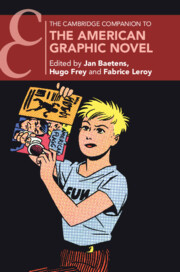Book contents
- The Cambridge Companion to the American Graphic Novel
- The Cambridge Companion to the American Graphic Novel
- Copyright page
- Contents
- Figures
- Contributors
- Editors’ Acknowledgments
- Introduction
- Part I History and Genre
- Part II Graphic Novels and the Quest for an American Diversity
- 10 Expressions of Jewishness alongside Grief in American Graphic Novels
- 11 Black Looking and Looking Black
- 12 African American New History-Writing in Graphic Narratives
- 13 Coming to America, “Land of the Free”
- 14 Spatiotemporal Projections
- 15 Queer Graphic Novels
- 16 American Women’s Lives in Graphic Novels
- Index
- Cambridge Companions To …
- References
16 - American Women’s Lives in Graphic Novels
Becoming and Unbecoming Women
from Part II - Graphic Novels and the Quest for an American Diversity
Published online by Cambridge University Press: 10 January 2024
- The Cambridge Companion to the American Graphic Novel
- The Cambridge Companion to the American Graphic Novel
- Copyright page
- Contents
- Figures
- Contributors
- Editors’ Acknowledgments
- Introduction
- Part I History and Genre
- Part II Graphic Novels and the Quest for an American Diversity
- 10 Expressions of Jewishness alongside Grief in American Graphic Novels
- 11 Black Looking and Looking Black
- 12 African American New History-Writing in Graphic Narratives
- 13 Coming to America, “Land of the Free”
- 14 Spatiotemporal Projections
- 15 Queer Graphic Novels
- 16 American Women’s Lives in Graphic Novels
- Index
- Cambridge Companions To …
- References
Summary
The history of comics and graphic novels often coincides with a history of marginalization of women and misogynistic stereotypes. Conversely, this chapter examines the representation of women by women in graphic novels, with a particular focus on women’s lives. It recalls the early efforts of women cartoonists within the underground comix of the 1960s and 1970s, such as Aline Kominsky-Crumb, Phoebe Gloeckner, and Julie Doucet, who produced different representations of femininity and sexuality than their male counterparts. It considers the contributions of seminal graphic memoirs by Marjane Satrapi and Alison Bechdel, which blended stories of personal awakening with a political context and message, offering new templates for future works. It also highlights the recurrence of the theme of childhood trauma in autobiographical works by women authors, such as Lynda Barry’s One Hundred Demons (2002), as well as the depiction of unequal work, career, household, and parenting demands placed on women. Finally, it reflects on the manner in which graphic novels by women authors may portray women’s experiences such as motherhood, abortion, and menopause, and considers graphic works that expand the notion of women’s discourse beyond binary identities.
Keywords
- Type
- Chapter
- Information
- The Cambridge Companion to the American Graphic Novel , pp. 272 - 290Publisher: Cambridge University PressPrint publication year: 2023

